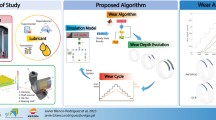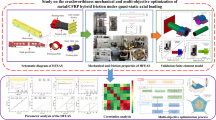Abstract
This paper proposes a methodology that combines the Finite Element Method and multiple response surface optimization to search for the optimal operating conditions of a double-row Tapered Roller Bearing (TRB) that has a Preload (P), radial load (Fr), axial load (Fa) and torque (T). Initially, FE models based on a double-row TRB are built and validated in the basis of experimental data and theoretical models. Three of the most important parameters used in the design of TRB were obtained from a simulation of the FE models with a combination of several operating conditions that were previously selected in accordance with a design of experiments. The design parameters are: contact stress radio for both rows of rollers (S1 and S2), maximum deformation of the outer raceway (αmax), and the difference between the gaps of the inner raceways (Δδ) or misalignment. Based on the results of the FE simulations, quadratic regressions models are generated that use the response surface method to predict the design parameters when new operating condition are applied. Then, a multi-response optimization study based on these models and using desirability functions is conducted. It is concluded that the accuracy of the results demonstrates that this methodology may be used to search for the optimal operating condition in a double-row TRB.










Similar content being viewed by others
Abbreviations
- \( l_{t} \) :
-
Rollers’ effective length (mm)
- \( d_{m} \) :
-
Mean diameter of tapered roller (mm)
- \( D_{\hbox{max} } \) :
-
Diameter of tapered roller at large end (mm)
- \( D_{\hbox{min} } \) :
-
Diameter of tapered roller at small end (mm)
- \( D_{m} \) :
-
Bearing pitch diameter (mm)
- \( D_{i} \) :
-
Bore diameter (mm)
- \( D_{o} \) :
-
Outer diameter (mm)
- L:
-
Longitude of the bearing (mm)
- Z:
-
Number of rollers
- \( b_{o} \) :
-
Semi minor axis of the projected contact ellipse (mm)
- \( K_{n} \) :
-
Load deflection factor
- \( \sigma \) :
-
Contact normal stress (MPa)
- \( \alpha \) :
-
Contact angle (°)
- \( \alpha_{i} \) :
-
Inner raceway-roller contact angle (°)
- \( \alpha_{o} \) :
-
Free contact angle (°)
- \( \alpha_{R} \) :
-
Tapered roller included angle (°)
- \( \sum {\rho_{o} } \) :
-
Curvature sum (mm−1)
- MAPE:
-
Mean Absolute Percentage Error
- RMSE:
-
Root Mean Square Error
References
Arora, V., van der Hoogt, P.J.M., Aarts, R.G.K.M., de Boer, A.: Identification of stiffness and damping characteristics of axial air-foil bearings. Int. J. Mech. Mater. Des. 7(3), 231–243 (2011)
Arora, V., Van der Hoogt, P.J.M., Aarts, R.G.K.M., de Boer, A.: Identification of dynamic properties of radial air-foil bearings. Int. J. Mech. Mater. Des. 6(4), 305–318 (2010)
Azaouzi, M., Lebaal, N., Rauchs, G., Belouettar, S.: Optimal design of multi-step stamping tools based on response surface method. Simul. Model. Pract. Theory 24, 1–14 (2012)
Bahloul, R., Mkaddem, A., Dal Santo, P.: Sheet metal bending optimization using response surface method, numerical simulation and design of experiments. Int. J. Mech. Sci. 48(9), 991–1003 (2006)
Borgelt, C., Gil, M.Á., Sousa, J.M., Verleysen, M.: Towards Advanced Data Analysis by Combining Soft Computing and Statistics. Springer, Berlin (2013)
Box, G.E., Behnken, D.W.: Some new three level designs for the study of quantitative variables. Technometrics 2(4), 455–475 (1960)
Box, G.E., Wilson, K.B.: On the experimental attainment of optimum conditions. J. R. Stat. Soc. A. Stat. 13(1), 1–45 (1951)
del Coz Diaz, J.J., Garcia-Nieto, P.J., Alvarez-Rabanal, F.P., Alonso-Martínez, M., Dominguez-Hernandez, J., Perez-Bella, J.M.: The use of response surface methodology to improve the thermal transmittance of lightweight concrete hollow bricks by FEM. Constr. Build. Mater. 52, 331–344 (2014)
Demirhan, N., Kanber, B.: Stress and displacement distributions on cylindrical roller bearing rings using FEM. Mech. Based Des. Struct. 36(1), 86–102 (2008)
Derringer, G., Suich, R.: Simultaneous optimization of several response variables. J. Qual. Technol. 12, 214–219 (1980)
Di Lorenzo, R., Ingarao, G., Chinesta, F.: Integration of gradient based and response surface methods to develop a cascade optimisation strategy for Y-shaped tube hydroforming process design. Adv. Eng. Softw. 41(2), 336–348 (2010)
El-Abbasi, N., Bathe, K.J.: Stability and patch test performance of contact discretizations and a new solution algorithm. Comput. Struct. 79(16), 1473–1486 (2001)
Eschmann, P., Hasbargen, L., Weigand, K.: Ball and roller bearings: theory, design, and application. R. Oldenbourg, Munich (1985)
Escribano, R., Lostado, R., Fernández, R., Villanueva, P., Mac Donald, B.J.: Improvement in Manufacturing Welded Products Through Multiple Response Surface Methodology and Data Mining Techniques. International Joint Conference SOCO’14-CISIS’14-ICEUTE’14, pp. 301–310. Springer International Publishing, Berlin (2014)
Feng, Q., Prinja, N.K.: NAFEMS Benchmark Tests for Finite Element Modelling of Contact. Gapping and Sliding, NAFEMS, Report (2001). R0081
Fisher, R.A.: The Design of Experiments. Oliver and Boyd, Oxford (1935)
Gelman, A.: Analysis of variance? Why it is more important than ever. Ann. Stat. 33(1), 1–53 (2005)
Guo, Y., Parker, R.G.: Stiffness matrix calculation of rolling element bearings using a finite element/contact mechanics model. Mech. Mach. Theory 51, 32–45 (2012)
Harrington, E.C.: The desirability function. Ind. Qual. Control 21(10), 494–498 (1965)
Harris, T.A., Kotzalas, M.N.: Essential Concepts of Bearing Technology. Taylor and Francis, New York (2006)
Hertz, H.: On the Contact of Rigid Elastic Solids and on Hardness, in Miscellaneous Papers. MacMillan, London (1896)
Illera, M., Lostado, R., Fernandez, R., MacDonald, B.: Characterization of electrolytic tinplate materials via combined finite element and regression models. J. Strain Anal. Eng. 49(6), 467–480 (2014)
Kania, L.: Modelling of rollers in calculation of slewing bearing with the use of finite elements. Mech. Mach. Theory 41(11), 1359–1376 (2006)
Kelly, D.W., Gago, D.S., Zienkiewicz, O.C., Babuska, I.: A posteriori error analysis and adaptive processes in the finite element method: part I—Error analysis. Int. J. Numer. Methods Eng. 19(11), 1593–1619 (1983)
Kuhn, M.: Desirability: desirabiliy function optimization and ranking. R package v.1.6. http://CRAN.R-project.org/package=desirability (2014)
Lenth, R.V.: Response-surface methods in R using RSM. J. Stat. Softw. 32(7), 1–17 (2009)
Lostado, R., Escribano, R., Fernández, R., Illera, M., Mac Donald, B.J.: Combination of the Finite Element Method and Data Mining Techniques to Design and Optimize Bearings. International Joint Conference SOCO’14-CISIS’14-ICEUTE’14, pp. 165–174. Springer International Publishing, Berlin (2014)
Lostado, R., Martínez De Pisón, F.J., Pernía, A., Alba, F., Blanco, J.: Combining regression trees and the finite element method to define stress models of highly non-linear mechanical systems. J. Strain Anal. Eng. 44(6), 491–502 (2009)
Lundberg, G., Sjövall, H. Stress and Deformation in Elastic Contacts, Publication no. 4. Institute of Theory of Elasticity and Strength of Materials, Chalmers Institute Technology, Gothenburg (1958)
Marwala, T.: Finite-element-model Updating Using Computational Intelligence Techniques: Applications to Structural Dynamics. Springer, Amsterdam (2010)
Meguid, S.A., Czekanski, A.: Advances in computational contact mechanics. Int. J. Mech. Mater. Des. 4(4), 419–443 (2008)
Montgomery, D.C.: Design and Analysis of Experiments. John, New Jersey (2008)
MSC Marc User's Guide Version 2010. MSC Software Corporation LA (2010)
Myers, R.H.: Response surface methodology. Allyn-Bacon, Boston (1971)
Nagatomo, T., Takahashi, K., Okamura, Y., Kigawa, T., Noguchi, S.: Effects of load distribution on life of radial roller bearings. J. Tribol. 134(2), 021101 (2012)
R Core Team.: R: A language and environment for statistical computing. R Foundation for statistical computing. http://www.R-project.org/ (2014)
Sathiya, P., Aravindan, S., Haq, A.N.: Optimization for friction welding parameters with multiple performance characteristics. Int. J. Mech. Mater. Des. 3(4), 309–318 (2006)
Satyanarayana, S., Melkote, S.N.: Finite element modeling of fixture-workpiece contacts: single contact modeling and experimental verification. Int. J. Mach. Tool Manuf. 44(9), 903–913 (2004)
Shigley, J.E., Mischke, C.R., Budynas, R.G.: Mechanical Engineering Design. Mc. Graw Hill, New York (2004)
Taguchi, G.: Introduction to Quality Engineering: Designing Quality into Products and Processes. Quality Resources, New York (1986)
Wilkinson, L., Dallal, G.E.: Tests of significance in forward selection regression with an F-to enter stopping rule. Technometrics 23(4), 377–380 (1981)
Yanhui, Y., Dong, L., Ziyan, H., Zijian, L.: Optimization of preform shapes by RSM and FEM to improve deformation homogeneity in aerospace forgings. Chin. J. Aeronaut. 23(2), 260–267 (2010)
Zavarise, G., De Lorenzis, L.: A modified node-to-segment algorithm passing the contact patch test. Int. J. Numer. Meth. Eng. 79(4), 379–416 (2009)
Zeng, G., Li, S.H., Yu, Z.Q., Lai, X.M.: Optimization design of roll profiles for cold roll forming based on response surface method. Mater. Des. 30(6), 1930–1938 (2009)
Zhang, X.P., Ahmed, H., Yao, Z.: Multi-body contact modeling and statistical experimental validation for hub-bearing unit. Tribol. Int. 36(7), 505–510 (2003)
Conflict of interests
The authors declare that there is no conflict of interests regarding the publication of this paper.
Author information
Authors and Affiliations
Corresponding author
Rights and permissions
About this article
Cite this article
Lostado, R., Escribano García, R. & Fernandez Martinez, R. Optimization of operating conditions for a double-row tapered roller bearing. Int J Mech Mater Des 12, 353–373 (2016). https://doi.org/10.1007/s10999-015-9311-4
Received:
Accepted:
Published:
Issue Date:
DOI: https://doi.org/10.1007/s10999-015-9311-4




